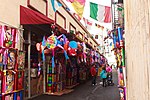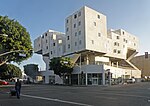Fire Station No. 23 (Los Angeles, California)

Fire Station No. 23 is a former fire station in Downtown Los Angeles. Built in 1910 as an operating fire station, it was also the Los Angeles Fire Department's headquarters until 1920 and the residence of every fire chief from 1910-1928. When it opened, it spawned a political firestorm due to the ornate interior and expensive imported materials, leading to its being called the "Taj Mahal" of firehouses. After 50 years of operation, the station was closed in 1960 as the department began replacing older stations with new facilities. Since the 1980s, Fire Station No. 23 has been a popular filming location. Motion pictures filmed at the station include the Ghostbusters movies, The Mask, Police Academy 2, Flatliners, Firehouse and National Security.
Excerpt from the Wikipedia article Fire Station No. 23 (Los Angeles, California) (License: CC BY-SA 3.0, Authors, Images).Fire Station No. 23 (Los Angeles, California)
East 5th Street, Los Angeles Downtown
Geographical coordinates (GPS) Address Nearby Places Show on map
Geographical coordinates (GPS)
| Latitude | Longitude |
|---|---|
| N 34.045694444444 ° | E -118.24672222222 ° |
Address
Fire Station 23 (Engine 23 Fire Co.)
East 5th Street 225
90013 Los Angeles, Downtown
California, United States
Open on Google Maps










